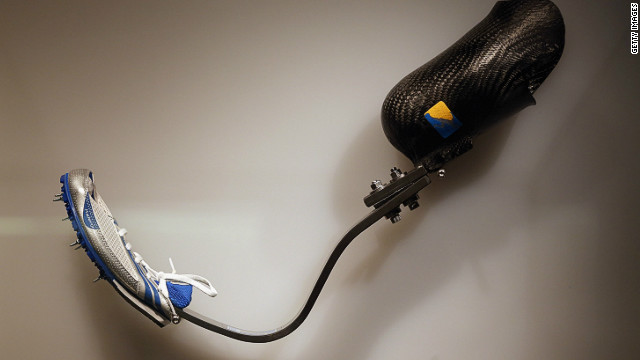
From hydrodynamic swimwear in the pool to lightweight carbon-fiber bicycles slicing through the air at the velodrome, the Olympic Games is once again shining a spotlight not only on the athletes, but also their kit.
The technology propelling athletes to glory in the future will be even more refined, taking bespoke equipment to another level says Mike Caine, professor of sports technology and innovation at the UK's Loughborough University.
"The sports industry talks a lot about customization at the moment. Typically, they mean you can pick your color and put your name on the shoe," Caine said.
"What I'm talking about is the bend and stiffness of a sole plate which can be optimized to give the most power for an individual athlete," he said.
Measuring the power, geometry and biomechanics of individual feet is enabling the creation of "tuned" midsoles in athletics shoes, says Caine, which can correct gait abnormalities or soft-tissue inefficiencies.
If you compare elite male runners with elite females they are very, very different. But at the moment the footwear is ostensibly identical
Mike Caine, Loughborough University
Mike Caine, Loughborough University
The soles are built using an additive manufacturing (also known as 3-D printing) system invented and patented at the university. Caine is confident it can deliver new gains on the track.
"If you compare elite male runners with elite females they are very, very different. But at the moment the footwear is ostensibly identical," he said.
This type of custom-built kit will become the norm for lots of elite sportsmen, he thinks, and will eventually filter down to the high street.
The research is one of several pioneering efforts being led by Loughborough's Sports Technology Institute, which works with public and private partners to drive innovation in sport's equipment and training.
Caine and colleagues are currently pioneering new tracking devices for swimmers, which employ body-mounted gyroscopes and accelerometers in tandem with cameras and sensors around the pool to monitor body position, acceleration, speed and power.
"(The data) removes ambiguity for an experienced coach. If you can provide quantified time and speed data, you reinforce learning behaviors," he said.
It works best with the technical sports like sailing and cycling and will only get more accurate as technology presses ahead, Caine says.
"If you speak to (aerodynamic and hydrodynamics) experts they say there is a lot more that can be done because our computational power will be at a level where we can understand the nuances of small changes," he said.
Rapid advances in equipment have encouraged some sporting bodies to reign in technology's influence.
In 1996, the Union Cycliste Internationale (UCI) published the Lugano Charter which drew up narrow guidelines on bicycle design, and in 2009 the swimming world governing body FINA outlawed Speedo's LZR Racer swimsuit (launched in 2008) after world records were routinely broken.
Sport is "heading towards a crossroads," according to the report "Sports Engineering: An Unfair Advantage?" published by the UK's Institution of Mechanical Engineers in July.
Regulators now face a "delicate task ... as sports technology becomes ever more powerful. The legal wrangling over Oscar Pistorius' move from the Paralympics to the Olympics is a sign of things to come," say the authors.
The South African double-amputee's appearance at London 2012 poses interesting philosophical questions, says Rayvon Fouche, associate professor of History at the University of Illinois, Urbana-Champaign, and author of the forthcoming book "Gamechanger: Technology and Science in Sport."
Well-informed governing bodies promote incremental changes which mirror the technological advances in wider society
Mike Caine
Mike Caine
"It really pushes us to think deeply about what sort of athletic competition we want to see. How far do we push the technology in a way that also doesn't undermine the authenticity of the sport?" Fouche said.
"There definitely needs to be a larger dialogue about what it means to live in a world where technology surrounds us at every moment."
Sport, he says, has always been played using emerging technologies with the goal being to find the largest legal advantage you can.
"In the last 30-40 years, technology is clearly the effective place to look for the substantial gains."
A wider conversation involving governing bodies, athletes, sports manufacturers and fans may help us define what sport is, Fouche says.
Caine agrees.
"Well-informed governing bodies promote incremental changes which mirror the technological advances in wider society. The key is to do it in concert with athletes and manufacturers," he said.
"What you don't want, in my view, is a disruptive technology that changes the essence of the sport and/or makes it completely unfair. What we like is human endeavour, which is the primary construct on which competitive sport is based."
No comments:
Post a Comment
SHARE AND COMMENT